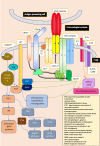Idiopathic CD4 Lymphocytopenia: Current Insights
- PMID: 32548074
- PMCID: PMC7239889
- DOI: 10.2147/ITT.S214139
Idiopathic CD4 Lymphocytopenia: Current Insights
Abstract
Idiopathic CD4 lymphocytopenia is a condition characterized by low CD4 counts. It is rare and most of the information about this illness comes from case reports. Presentation is usually in the 4th decade of life with opportunistic infections, autoimmune disease or neoplasia. The pathophysiology of this condition is not well understood. Management revolves around treatment of the presenting condition and close follow-up of these patients. This review presents a narrative summary of the current literature on idiopathic CD4 lymphocytopenia.
Keywords: CD4 T cell lymphocytopenia; autoimmune disease; neoplasia; opportunistic infections.
© 2020 Vijayakumar et al.
Conflict of interest statement
The authors report no conflicts of interest in this work.
Figures


References
-
- Centers for Disease Control. Unexplained CD41 T-lymphocyte depletion in persons without evident HIV infection. Morb Mortal Wkly Rep. 1992;41. - PubMed
Publication types
LinkOut - more resources
Full Text Sources
Research Materials

